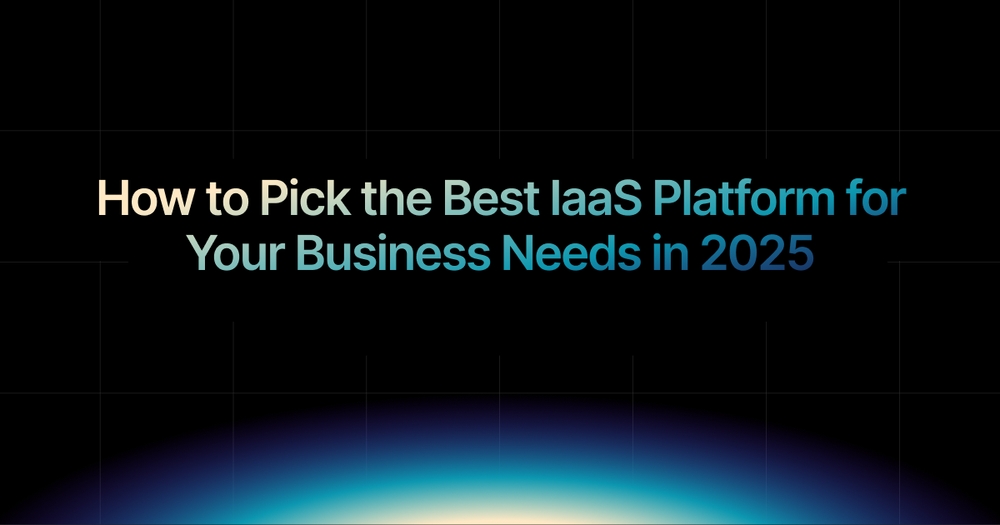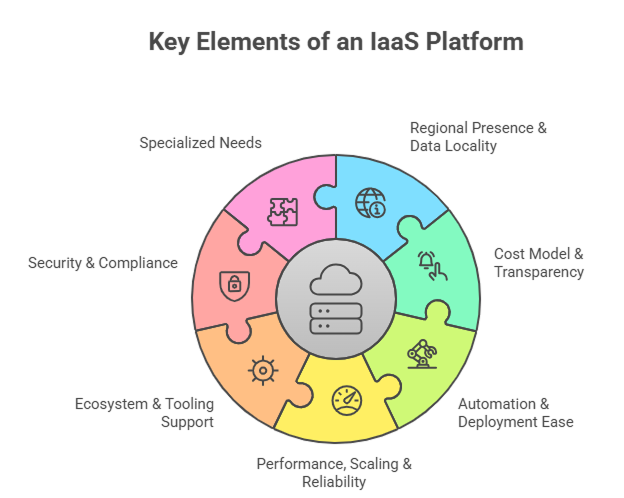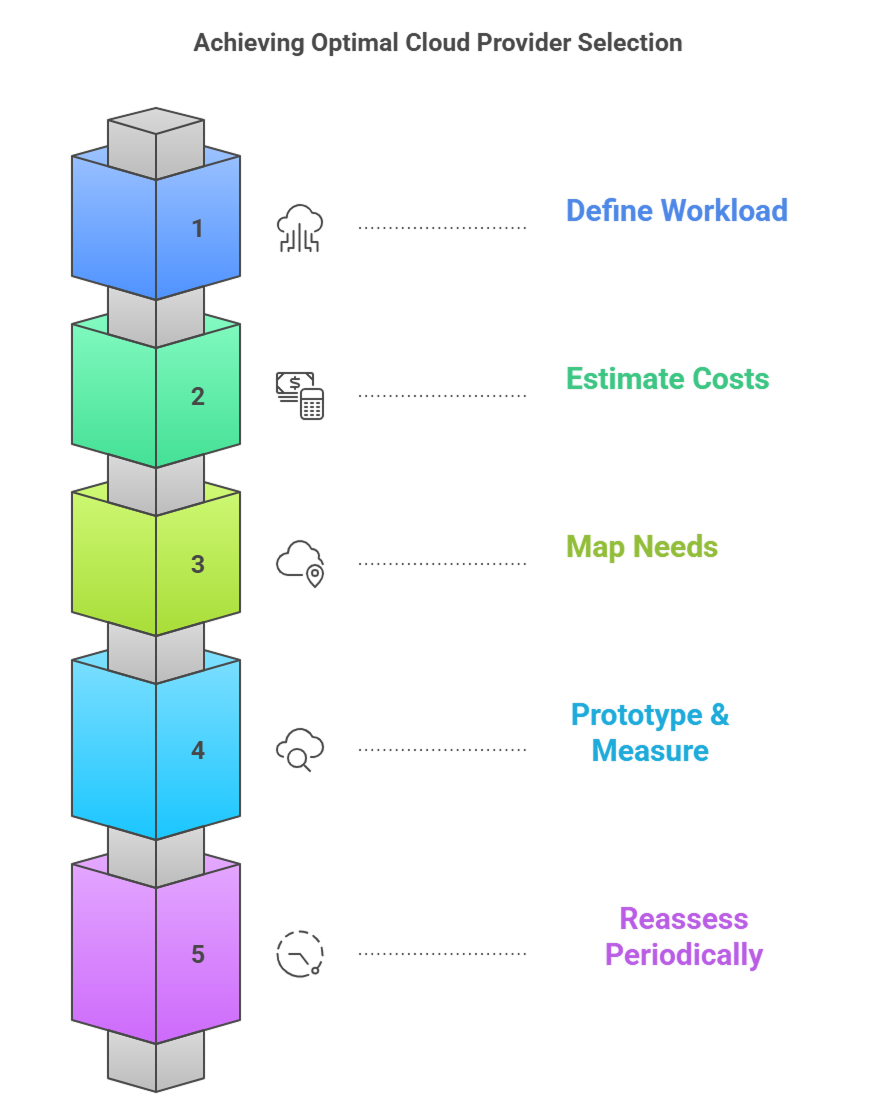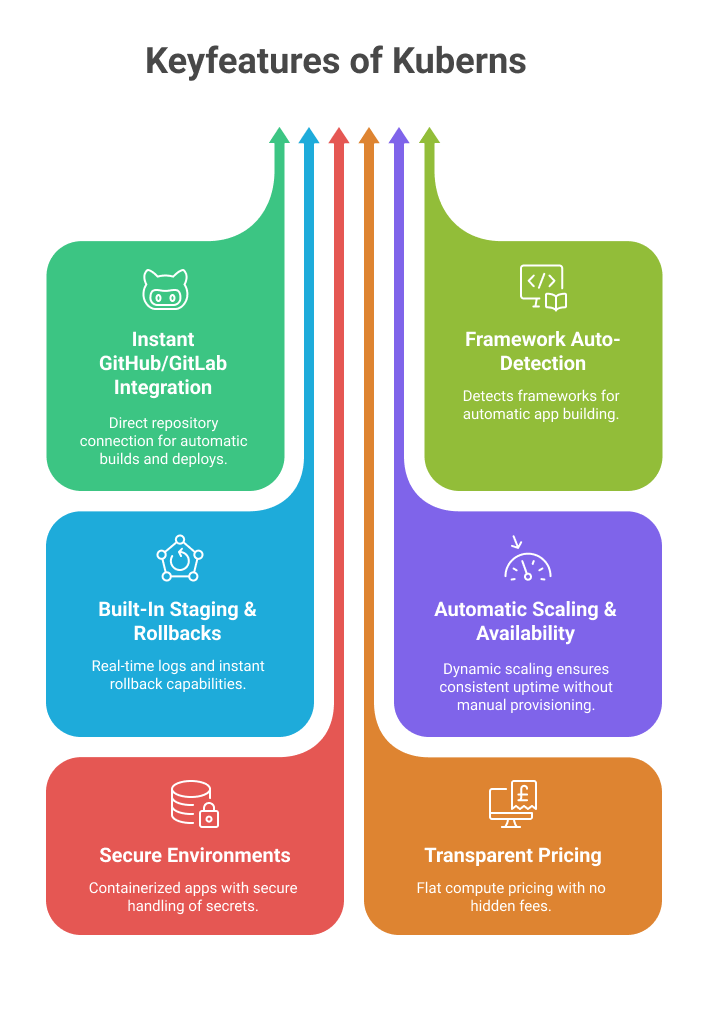Published
- 10 min read
How to Pick the Best IaaS Platform for Your Business Needs in 2025

Introduction
Infrastructure as a Service (IaaS) remains a crucial foundation for digital growth. Whether you are launching your first application, scaling a SaaS business, or managing enterprise-level workloads, your choice of IaaS directly impacts performance, security, cost, and delivery speed.
In 2025, the IaaS landscape is more diverse and demanding than ever. Businesses now expect not just compute and storage, but automation, flexibility, predictable pricing, global reach, and seamless scaling. Platforms like Kuberns help teams meet these needs by automating deployment, scaling, and monitoring, so developers can focus on building rather than managing infrastructure. Learn more about how Kuberns works here: What Is Kuberns: The Simplest Way to Build, Deploy, and Scale Full-Stack Apps.
This article guides you through a decision framework to pick the best IaaS platform for your business needs, whether you are a startup, agency, or enterprise.
What Matters Most in an IaaS Platform
 Choosing the right IaaS provider can be overwhelming, but focusing on a few critical dimensions helps you compare meaningfully. These are the capabilities that most determine real-world success.
Choosing the right IaaS provider can be overwhelming, but focusing on a few critical dimensions helps you compare meaningfully. These are the capabilities that most determine real-world success.
1. Regional Presence & Data Locality
Geography matters for speed and compliance. If your servers are far from your users, latency increases and user experience suffers. Also, certain laws may require data to stay within specific boundaries.
- Proximity to end users lowers latency and improves responsiveness
- Data sovereignty and local regulations may require specific regional storage
- Redundancy via multiple availability zones or regions improves uptime
2. Cost Model & Transparency
Pricing isn’t just about the cost of compute. Hidden expenses can erode your budget unexpectedly. You want predictable costs and efficient use of resources.
- Pricing models: on-demand, reserved, spot/preemptible, committed use
- Hidden costs: data egress, IOPS, storage throughput, load balancing, network fees
- Waste reduction: idle-resource detection, autoscaling, usage monitoring
- Predictable pricing helps with budgeting; flexible pricing suits variable workloads
- For deeper insights into managing cloud spend, see our guide to Cloud Cost Optimisation
3. Automation & Deployment Ease
Automated deployment reduces setup time and errors, enabling teams to focus on application development rather than infrastructure.
- Support for CI/CD pipelines, container orchestration, logging, alerts, and monitoring
- Deployment modes: one-click, templates, minimal configuration
- Faster time to market with fewer manual steps
- Learn best practices in How to Implement One-Click Automated Software Deployment
4. Performance, Scaling & Reliability
Workloads must scale smoothly and maintain availability even under load or partial failures.
- Autoscaling that adapts to real usage without manual intervention
- Health checks, self-healing nodes, and built-in redundancy
- Diverse compute options: CPU, GPU, burstable, reserved, etc.
- Service level agreements (SLAs) for uptime and availability
5. Ecosystem & Tooling Support
A rich ecosystem ensures that your infrastructure works well with other services and that your team can move quickly.
- Managed services: databases, analytics, messaging, AI/ML, identity, security
- Documentation, SDKs, APIs, and command line support
- Developer resources, community support, and training materials
- Integration with CI/CD tools, monitoring systems, and third-party software
6. Security & Compliance
Your infrastructure must protect data and meet regulatory demands from the start.
- Encryption in transit and at rest
- Identity and access management (IAM), secret management, and role-based permissions
- Audit logs, security certifications (e.g. GDPR, SOC, ISO)
- Network isolation, VPNs, private links, and hybrid cloud options
7. Specialised Needs (AI/ML, GPUs, Legacy, Hybrid, etc.)
Some workloads need more than just “standard compute.” Your provider should support your specific architecture and industry requirements.
- GPU or high-performance computing for machine learning and rendering
- Hybrid and multi-cloud options if you maintain on-premise or want failover across clouds
- Regional or vertical specialization, depending on your users or compliance needs
- Legacy support if you are migrating older systems to the cloud
How to Use These Criteria in Practice
Once you have defined what matters most in an IaaS platform, the next step is applying those criteria to your actual workloads. Use a structured decision-making approach that helps you test, measure, and refine your infrastructure choices.

1. Define Your Workload Type and Growth Pattern
Start by clarifying what your apps or services need right now, and how they might change as your product or user base grows.
- Is traffic stable, seasonal, bursty, irregular, or highly variable?
- Are you building web applications, mobile back-ends, APIs, machine learning pipelines, or large data systems?
- Do you expect predictable demand, occasional spikes, or growth over time?
2. Estimate Your Cost Envelope and Tolerance
Understanding what you can spend and what makes costs predictable is critical.
- What is your acceptable budget for compute, storage, data transfer, and networking?
- Are you okay with variable billing, or do you prefer fixed monthly costs that you can forecast?
- Do you want to commit to reserved usage for discounts, or use on-demand/spots for flexibility?
3. Map Your Needs to Provider Strengths
Match your workload and cost requirements with what each IaaS provider does best.
- If your users are global and latency matters, choose providers with many regions and zones.
- If you have strict compliance or regulatory constraints, review certifications and data-locality features.
- If your team has limited DevOps capacity or you want to minimize overhead, focus on platforms that provide automation, simple deployment, and built-in monitoring.
4. Prototype Small, Measure Actual Usage
A real-world trial reveals what the billing charts and specs cannot show.
- Run small representative workloads to test performance, cost, scaling behavior, and configuration simplicity.
- Monitor usage, latency, throughput, downtime, and cost.
- Adjust cluster sizes, compute types, and autoscaling rules based on real data.
- Keep an eye on idle or overprovisioned resources and optimize them to reduce waste.
5. Reassess Periodically
Cloud needs evolve along with your product, user growth, and traffic patterns.
- Review your infrastructure metrics regularly (for example quarterly or after major changes).
- Consider migrating if another platform offers better cost savings, automation, or performance for your use case.
- Stay aware of new features, regions, and pricing changes offered by providers.
Why Kuberns Is a Smart Option in Your Comparison
 When your priorities are speed, cost efficiency, and minimal DevOps burden, Kuberns offers a powerful combination of automation and infrastructure control. Here’s how it meets the key criteria you should be evaluating:
When your priorities are speed, cost efficiency, and minimal DevOps burden, Kuberns offers a powerful combination of automation and infrastructure control. Here’s how it meets the key criteria you should be evaluating:
- Reliable, global foundation Built on trusted AWS infrastructure, Kuberns inherits global region coverage, high availability, robust security, and uptime characteristics. You get the same backbone as world-scale applications without needing to manage network and region configurations manually.
- Code-first deployment and automated ops Write your code in Node.js, Python, containers, or microservices, commit it to your Git repo, and Kuberns handles provisioning, scaling, monitoring, and alerting. Developers don’t need to build custom infrastructure pipelines from scratch, reducing setup time and risk.
- Cost reduction and efficiency Kuberns helps identify idle or over-provisioned resources, right-sizes compute, and optimizes usage. Many teams experience up to 40 % savings on AWS infrastructure costs by eliminating wasteful spending and improving resource utilization. Learn how to reduce AWS cost in practice.
- Unified observability and tooling Instead of stitching together multiple monitoring, logging, alerting, and dashboard tools, Kuberns delivers a unified dashboard with observability, real-time logs, and performance metrics out of the box. You have less tool-maintenance overhead and more clarity on system health.
- Intelligent automation via AI Kuberns uses AI to drive parts of the deployment, scaling, and monitoring workflow. This helps automate operational decisions, such as scaling thresholds and resource provisioning, improving developer productivity and reducing manual intervention. Explore how AI in DevOps and developer workflow is transforming infrastructure management.
- Team focus on features, not infrastructure Because many of the infrastructure challenges are managed by Kuberns, your engineering teams can concentrate more on product features, application logic, user experience, and business value, rather than managing servers, autoscaling rules, or cloud monitoring scripts.
Final Thoughts
Selecting the right IaaS platform in 2025 means making trade-offs across your technical needs, growth trajectory, cost tolerance, and the level of control your team wants over operations. There is no one-size-fits-all “best” platform, but you can choose the one that best aligns with your goals.
If your priorities include fast and repeatable deployments, automation that reduces manual effort, clear cost visibility and control, and minimal infrastructure maintenance, then Kuberns stands out as a strong alternative. It lowers operational overhead, ensures performance, and helps teams deploy and scale with confidence.
Ready to get started? Visit kuberns.com to explore features, pricing, and how your team can begin deploying smarter with less effort.

Frequently Asked Questions (FAQ’s)
What is an IaaS platform and why does it matter for businesses?
Infrastructure as a Service (IaaS) delivers virtualized compute, storage, and networking resources over the internet. It matters because it forms the base on which your applications, data, and workloads run. Choosing the right IaaS influences performance, cost, speed of delivery, and scalability.
How do regional presence and data locality affect cloud performance?
Regional coverage matters because closer infrastructure reduces latency, improves user experience, and helps with legal or regulatory data residency and sovereignty requirements. Multiple availability zones and regions improve redundancy and uptime.
What hidden costs should businesses watch for when using IaaS?
Hidden costs can include data egress (transfer out of the cloud), network fees, storage IOPS, load balancing charges, and premium pricing for certain instance types. Being aware of these helps avoid surprise bills.
Why is deployment automation important in modern IaaS usage?
Manual infrastructure setup is time-consuming and error-prone. Automation ensures faster, safer deployments. It supports CI/CD, container orchestration, logging, monitoring, and alerts. Automation reduces DevOps overhead and lets teams focus on application development.
How can businesses estimate their acceptable cloud cost and budget?
Start by forecasting expected traffic, compute usage, storage needs, data transfer, and peak loads. Choose pricing models (on-demand, reserved, committed use, etc.) that match your budget tolerance. Monitor actual usage and refine your cost estimates over time.
What role does scalability and reliability play in choosing IaaS?
Scalability ensures you can handle traffic spikes without manual intervention. Reliability, through features like health checks, self-healing nodes, and multiple zones, ensures your infrastructure remains available. These determine whether your application delivers consistent performance under load.
Which workloads or use cases need specialized infrastructure features, like GPUs or hybrid setups?
Machine learning, graphics, large data processing, or high-performance computing often need GPUs or special compute shapes. Legacy systems or on-premise infrastructure may need hybrid or multi-cloud setups. Choose platforms that support your domain’s specific requirements.
How does Kuberns compare when speed, cost efficiency, and DevOps overhead are priorities?
Kuberns is designed for fast deployment, automatic scaling, observability, and cost optimization. It helps teams reduce provisioning time, reduce unnecessary resource usage, and maintain reliable performance. If you want automation and less infrastructure burden, Kuberns is a strong candidate.
When is it worth prototyping or testing cloud workloads before full production deployment?
Prototyping is important to check cost behavior, latency, scaling, and performance. It reveals real usage patterns, helps you adjust cluster sizes, compute types, and scaling rules, and prevents over-provisioning or idle resources. Testing gives you data to drive better infrastructure decisions.
How often should a business re-assess their cloud infrastructure choice?
Reassessment should happen periodically, especially after changes like traffic growth, feature expansion, regulatory updates, or cost shifts. A quarterly, biannual, or major release review is a good rhythm to check whether your provider still fits your needs or whether migration is justified.